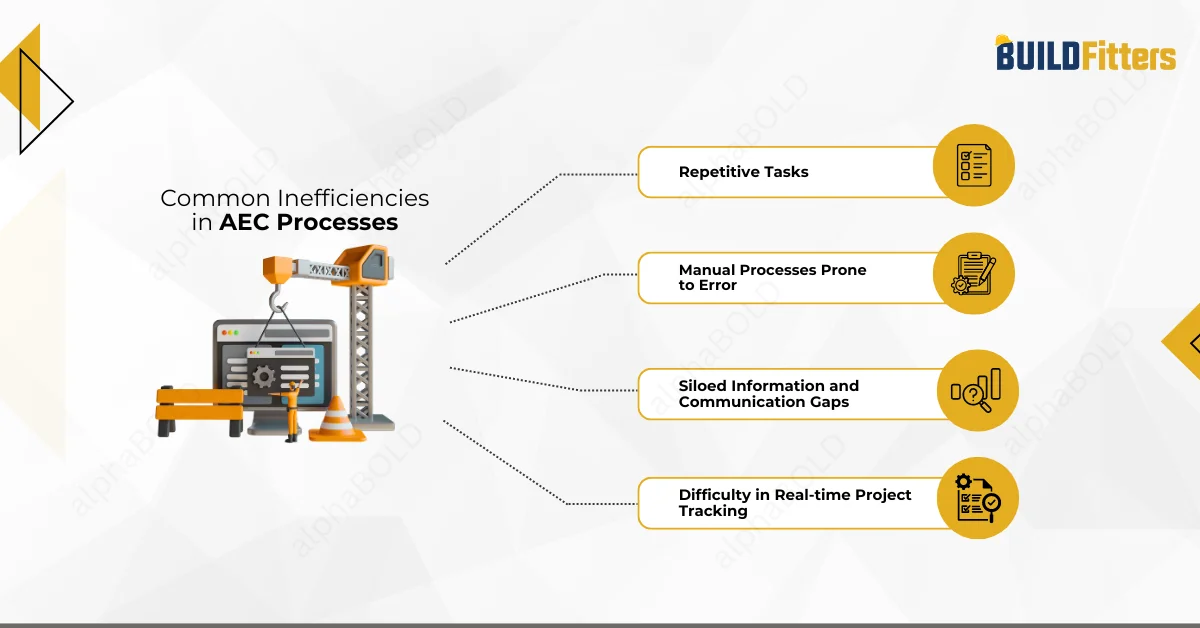
Automation in the AEC Sector
Introduction
Imagine a project delayed by weeks, budgets blown due to rework, and skilled workers bogged down by repetitive tasks. This, unfortunately, is a familiar reality for many in the AEC industry. A staggering 16% of construction productivity is lost annually due to rework caused by manual errors. This inefficiency isn’t just a headache; it’s a drag on progress and profitability. Automation in the AEC sector refers to leveraging technology to handle repetitive tasks, streamline workflows, and improve data accuracy. From design and documentation to construction and project management, automation offers a path to a more efficient, cost-effective, and competitive future.
This growing importance of automation in construction is driven by several key factors. Increased competition and tighter margins demand more efficient use of resources. Project complexity is on the rise, with intricate building designs and integration of advanced technologies. Labor shortages and skilled worker gaps further emphasize the need for automation to augment human expertise, not replace it. By embracing automation, AEC firms can unlock a new level of efficiency and gain a significant edge in today’s demanding market.
The Inefficiency Monster: Devouring Time, Resources & Profitability
The promise of automation in the AEC sector takes on even greater significance when we delve into the persistent drag of inefficiency plaguing current workflows. Here are some of the common culprits:
- Repetitive Tasks: Imagine the countless hours spent on manual data entry, updating drawings with minor revisions, or generating routine reports. These repetitive tasks not only drain valuable time and resources, but also leave room for human error.
- Manual Processes Prone to Errors: AEC projects rely heavily on manual processes, from calculations and code checks to document creation and communication. Unfortunately, these manual steps are susceptible to errors, leading to rework, delays, and potential safety hazards.
- Siloed Information and Communication Gaps: With information fragmented across different teams and software platforms, communication breakdowns and a lack of real-time data visibility are common. This can lead to misunderstandings, duplicated efforts, and delays in decision-making.
- Difficulty in Real-Time Project Tracking: Manually tracking project progress can be cumbersome and time-consuming. Without real-time data and insights, it’s difficult to identify potential issues early on, proactively manage resources, and make informed decisions.
The consequences of these inefficiencies are far-reaching. Wasted time and resources translate to higher project costs. Manual errors lead to rework, further extending timelines and pushing budgets beyond their limits. Delays ripple through the entire project ecosystem, impacting client satisfaction and hindering a firm’s reputation. Most importantly, these inefficiencies can contribute to safety hazards on construction sites due to inaccurate information or miscommunication.
The Solution: Automation in The AEC Sector Use Cases
Automation offers a powerful solution, streamlining workflows and boosting efficiency across all project stages. Let’s explore some key use cases and the benefits they bring.
Design Automation:
Imagine design software that can automatically generate repetitive elements like floor plans, window placements, or MEP (Mechanical, Electrical, and Plumbing) layouts. This frees up valuable time for architects and engineers to focus on creative problem-solving and complex design challenges. Furthermore, automation can handle code compliance checks, ensuring designs meet regulations and avoiding costly rework down the line. The result? Increased efficiency, fewer errors, and designs that meet the highest standards.
Ready to Automate?
Ready to transform your AEC projects with the power of automation? Explore the possibilities further. Contact us for a free consultation to discuss your specific needs and goals.
Documentation Automation:
Say goodbye to tedious manual report generation and data population in construction documents. Automation tools can populate forms and reports with accurate data from various sources, saving countless hours and eliminating the risk of human error. This translates to faster turnaround times for documents like submittals and inspections, keeping projects on track. Improved accuracy also minimizes delays due to missing or incorrect information.
Construction Automation:
The benefits of automation extend to the construction site as well. Scheduling software can optimize workflows, considering factors like resource availability and weather conditions, to minimize delays and keep projects on schedule. Material procurement can also be automated, ensuring timely delivery of materials and reducing the risk of on-site shortages. The result? Reduced rework due to better planning and resource allocation, leading to a smoother construction process and improved project outcomes.
Project Management Automation:
Gain real-time visibility into your project’s progress with automated tracking tools. These solutions continuously collect data on tasks, resources, and potential risks. With this information readily available, project managers can make informed decisions, identify and mitigate issues before they escalate, and ensure projects stay within budget and timeframe. Automation empowers proactive decision making, leading to a more controlled and predictable project environment.
By implementing automation across these areas, AEC firms can unlock a new level of efficiency, reduce costs, improve project outcomes, and gain a significant competitive advantage. In the next section, we’ll explore some key considerations for implementing an automation strategy in your firm.
Further Reading: Revolutionizing Construction Project Management With AI
Implementing Automation in Your AEC Firm
The potential of automation in the AEC sector is undeniable. But how do you translate this potential into real-world results for your firm? Here are some key considerations for implementing a successful automation strategy:
- Identifying the Right Use Cases: Not all automation solutions are created equal. The first step is to carefully analyze your workflows and identify the areas where repetitive tasks, manual processes, or information silos are causing the biggest bottlenecks. Focus on use cases that offer the greatest potential for efficiency gains and cost savings, aligning with your firm’s specific needs and project types.
- Selecting the Appropriate Software Tools: The vast landscape of AEC software can be overwhelming. Once you’ve identified your target use cases, research and evaluate different automation tools. Consider factors like compatibility with your existing software ecosystem, ease of use, scalability, and integration capabilities. Consulting with industry experts or software vendors can be invaluable in navigating this process.
- Preparing Your Team for Change Management: Embracing automation is not just about technology; it’s about people. Successfully implementing automation requires preparing your team for the change. Provide clear communication about the benefits of automation, address potential concerns, and offer training on new software and workflows. Building employee buy-in is crucial for maximizing the impact of automation in your firm.
- Partnering for Success: Consider partnering with a consulting firm experienced in AEC automation implementation. These experts can guide you through the entire process, from identifying the right use cases to selecting software and managing change within your team. Their expertise can help ensure a smooth transition and maximize the return on your automation investment.
By carefully considering these factors and potentially partnering with the right resources, your AEC firm can pave the way for a more efficient, cost-effective, and competitive future.
Further Reading: Future-Proofing Technology in Your Construction Business
Ready to Automate?
Don’t wait to unlock the power of automation in your AEC firm. Request a free consultation with our experts today and see how we can help you chart your course to success.
Conclusion
The message is clear: automation in the AEC sector is not a passing trend, but a transformative force. By leveraging automation to streamline workflows, eliminate inefficiencies, and improve data accuracy, AEC firms can unlock a new level of efficiency, reduce project costs, and achieve superior outcomes.
From design automation that frees up creative minds to automated project management that empowers proactive decision-making, the benefits of automation are far-reaching. In today’s competitive landscape, embracing automation is no longer a choice, but a necessity for firms seeking a sustainable competitive advantage.

